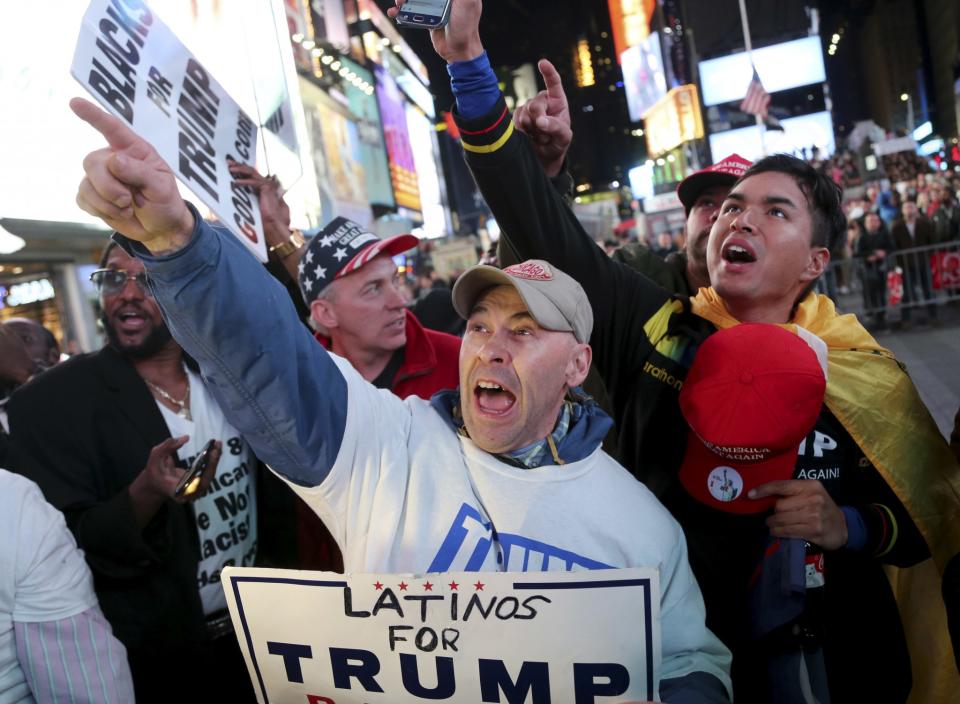Trump’s victory stunned even GOP digital team
No one saw this coming. Not the Trump campaign. Not the Republican National Committee.
The best data inside the Trump campaign and the RNC had Donald Trump’s chances of winning the presidency as a one-in-five proposition.
Last Friday, the RNC gathered a handful of reporters inside its Capitol Hill headquarters in Washington to share what its most up-to-date election model showed.
RNC staffers thought Trump would win 240 Electoral College votes, 30 short of the 270 needed to win. They cautioned reporters that these numbers could change. And it was noteworthy that their projections were more optimistic than much of the public polling. But Trump was down 2 points in Florida, down 2 points in Iowa, down 2 points in New Hampshire and down 3 points in Wisconsin. Trump won Florida, won Iowa, won Wisconsin, and as of the publishing of this story was in a tight race for New Hampshire.
The best data inside the Trump campaign was just as pessimistic. Even the most optimistic models run by Cambridge Analytica for Trump showed him losing. But as Cambridge’s Matt Oczkowski tweeted late Tuesday, Trump’s support and turnout among rural voters was 10 percentage points higher than they had expected.
Even the fact that the RNC held the data briefing was evidence it thought Trump was likely to lose. Staffers wanted journalists to be able to report that their information was accurate in order to protect one of their chief assets in what most thought would be a fight for control of the party after Trump’s loss.
But Trump’s surprise victory was just one of the many things that did not go according to plan for the RNC and its chairman, Reince Priebus, in the 2016 campaign.
Priebus, the RNC chairman for six years now, was powerless to stop Donald Trump — who was not the first choice of a majority of Republican primary voters — from becoming the party’s presidential nominee. Then, when Priebus did put his finger on the scales, it was to push Trump over the hump, helping secure the nomination for a candidate who took the recommendations Priebus and the RNC made in 2013 for a more positive, inclusive and conservative party, and threw them out the window.
But even if the leaders of the RNC — like most in the GOP establishment — thought that a Trump nomination would be a debacle in most ways, they also thought they saw a silver lining.
Trump’s lack of a campaign infrastructure allowed the RNC to run more of the presidential campaign than is normal. The RNC’s resulting gains in data and technology would have helped it in a fight for the soul of the party, even if Trump would have been able to use a massive RNC-built data file to help him wage war against the party from the outside.
When the Republican primary narrowed to Trump and Sen. Ted Cruz, most Republicans did not think either could win the general election against Hillary Clinton. The RNC concluded at some point that there was a way to make lemonade with Trump as nominee.

“After going through this incredibly challenging cycle, we wanted to ensure that the RNC would come out of this being able to say, ‘Here are the reasons that the party is stronger,’” RNC chief of staff Katie Walsh told me. “There’s a whole list of challenges we face moving forward, but what are the things we’re stronger for? One of them was a very robust email file that we could continue to build to raise money for the party and engage with voters.”
After Trump’s campaign tried to build and run an email fundraising effort, its spam levels were so high that it had to hand the job off to the RNC. The RNC has also overseen Trump’s digital advertising efforts out of San Antonio, where the Trump campaign’s digital director, Brad Parscale, lives and works. The RNC paid for new office space for the operation, and the RNC’s director of advertising, Gary Coby, and head of email fundraising, Parks Bennett, moved out to Texas to oversee the operation a few days after Cruz and Ohio Gov. John Kasich dropped out of the race in early May.
The RNC and Parscale’s operation worked with Cambridge Analytica’s Oczkowski, who arrived in San Antonio in mid-June, to help build a SQL (structured query language) database that collected the data being gathered by the RNC’s digital advertising and email fundraising, as well as 14 to 18 custom models of the electorate built by Cambridge. Parscale named this Project Alamo.
The Trump campaign also relied for their get-out-the-vote (GOTV) effort on the RNC’s analytical models of each battleground state, built on top of the RNC’s voter file.
Cambridge’s models were used for digital persuasion efforts, though not for mail or phones, Parscale told Yahoo News. This was because, while the RNC had spent years trying to identify as many generic Republican voters across the country as possible, Trump was attracting a different kind of person: sporadic or unreliable voters disillusioned with politics in general and with both political parties. That was the kind of voter that Cambridge had focused on identifying in the electorate and was the focus of the voter universe models it built.
The RNC’s data analytics operation, along with the data from Cambridge, gave the Trump campaign a more sophisticated sense of which voters it should be targeting. Trump on his own was not able to do much to make use of this information. He invested very little in hiring state-based staff to build out a ground game.
The RNC, however, did have a more robust ground organizing effort than it did in 2012. Four years ago, it had put 876 staff in a dozen battleground states. By the end of the 2016 cycle, there were 3,068 RNC paid field staff working to organize volunteers, and almost another 3,000 organizers in training under the RNC’s Republican Leadership Institute.
Trump did transfer $50 million to the RNC through their joint fundraising agreement, which helped to pay for field staff. That was almost $100 million less than the $140 million Romney transferred to the RNC in 2012.

And so when Parscale and others on the campaign bragged to a Bloomberg journalist that they had created a voter database of Trump supporters that the RNC did not have access to, the RNC top command pushed back.
“The idea, to me, that they could build this whole thing without us, I can’t conceptualize how that would be possible,” Walsh said. “I also know that they have been running as a campaign from such a rapid pace. I don’t know when they would’ve done this.”
Parscale called it a “misconception” that he or the Trump campaign “somehow have something separated from [the RNC] in a way that is somehow going to hurt them.”
“The RNC has been a great partner. They are the reason we are where we are,” Parscale said in an Election Day phone call.
Walsh spoke highly of Parscale’s abilities, but did not mince words about his limitations, given the fact that he’d never worked on a political campaign of any kind.
“I would go on the record effusively praising Brad and saying that he has been great to work with. I would also go on record saying Brad had never worked in politics before and he would even admit that he knew almost nothing about politics before this,” Walsh said. “There were a lot of times when Brad would admit, ‘Yeah, I don’t know.’ But he’s a really smart guy. What I love about Brad, to be totally honest, is that Brad admits what he doesn’t know.”
By all accounts, it was Walsh and Parscale that did a lot to mend relations between the Trump campaign and the RNC over the summer, when the relationship between the two entities was fraying.
Still, Walsh believed Trump would use the data he’d built up “to build a brand for Trump that’s going to sell, whether it be Trump TV, or whatever Mr. Trump decides he wants to sell to that audience.”
“What the RNC wants out of those people is to keep learning about them and engaging with them, so that in four years we know what to tell our nominee to talk to them about,” she said. “We don’t want them to buy anything from us right now. We don’t need them to do anything with us other than to open an email every once in a while. We want engagement. We don’t need to convert them in any real way immediately, we want them to keep talking.”
All of that, of course, is now moot.
But the GOP was no match for Trump, and now he owns not only the data, but the party itself.
_____
Related slideshows:
Protests after Donald Trump’s victory >>>
Newspapers around the world react to Donald Trump’s victory >>>
Tears and cheers as Donald Trump and Hillary Clinton supporters clash at the White House >>>
World reaction to Trump’s stunning victory >>>
Trump defeats Clinton in 2016 election >>>
Election Night in America! >>>
Americans go to the polls to elect the 45th president >>>
Hillary Clinton and Donald Trump hold final rallies on Election Day eve >>>
Donald Trump’s America, Part 2 >>>
Donald Trump inspires his own brand of fashion on the campaign trail >>>
Face-off: Documenting the expressive battle between Hillary Clinton and Donald Trump >>>





